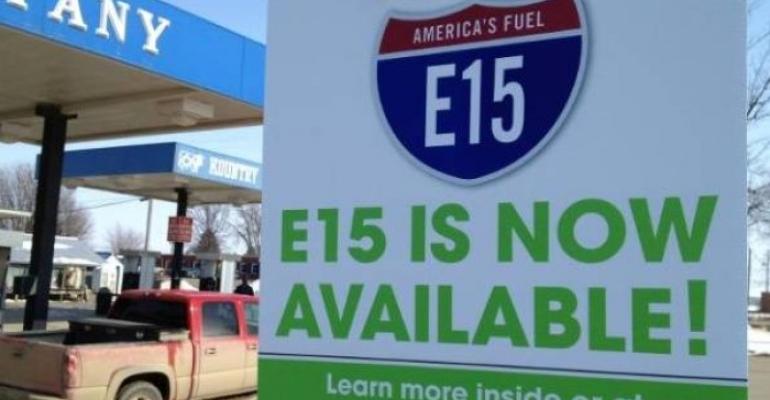A bipartisan group of lawmakers recently introduced legislation in the U.S. House of...
What’s Next for E15 After Biden’s Announcement?

The last time a sitting President visited an ethanol plant was to announce the availability of year-round E15 by then President Donald Trump. With Biden’s visit to an Iowa ethanol plant on April 12, he too offered a path forward for year-round E15 use.
Under Biden’s request, the Environmental Protection Agency is going to issue an emergency waiver to allow E15 gasoline sales to continue. “With this waiver, on June 1, you’re not going to show up at your local gas station and see a bag over the pump that has the cheapest gas. You’re going to be able to keep filling up with E15,” states President Joe Biden. “And we’re not just leaning on our reserves or our allies and partners to help bring down gas prices and to power the nation. We’re leaning on you, our farmers, our biofuel refiners.”
Robert White, Vice President of Industry Relations at the Renewable Fuels Association (RFA), says in discussions with retailers who offer E15 they’re very encouraged by the announcement and anticipate being able to continue to offer the higher fuel blend without any hiccups.
It is hard to predict the demand picture under the expanded E15 scenario, but lower estimates of a continued status quo indicate at least 300 million gallons of additional ethanol could be used by consumers with the year-round use of E15. “But, if you are expanding the number of E15 stations and E85 at a clip that they have this year, especially in the last few weeks when the weather allows for station development, I could see us quickly climbing from there. If more retailers move to this, it will also create increased demand for ethanol,” White says.
RFA released a new analysis that found sales of E15 blended gasoline hit a record 814 million gallons in 2021. That volume represented a 62% increase over the prior year and was nearly double pre-pandemic sales volumes in 2019. White adds that E85 sales in California are “off the charts” given the large differential cost advantage.
According to the National Corn Growers Association, if just one-third of regular E10 fuel sales were replaced with E15, it would fully replace all gasoline from previously imported Russian oil.
Growth Energy reports that E15 is available at more than 2,600 gas stations across 31 states. In tandem with the visit, USDA announced additional money through its Higher Blends Infrastructure Incentive Program (HBIF). White adds the announcement provides additional incentives for some retailers to make investments in higher blend infrastructure.
USDA announced funding in seven states to build infrastructure to expand the availability of higher-blend renewable fuels by approximately 59.5 million gallons per year. States included in this investment are California, Delaware, Illinois, Maryland, New Jersey, New York and South Dakota. For example, in Illinois, Power Mart Express Corp., DBA PME, is receiving a $2.9 million grant to increase ethanol sales by 17.5 million gallons per year. This project will replace 293 dispensers and 30 storage tanks at 15 fueling stations in Chicago, Maywood, Cicero, Des Plaines and Wilmington.
USDA also announced $100 million in new funding for grants for biofuels infrastructure to make it easier for gas stations to sell and to significantly increase the use of higher blends of bioethanol and biodiesel at the pump. The funding will provide grants to refueling and distribution facilities for the cost of installation, retrofitting or otherwise upgrading infrastructure required at a location to ensure the environmentally safe availability of fuel containing ethanol blends of E15 and greater or fuel containing biodiesel blends B-20 and greater. USDA will also make funding available to support biofuels for railways as a means of assisting with supply chains and helping to reduce costs for consumer goods and transportation.
White says, “This $100 million in matching grants provided to fuel retailers is a long-term play with no effect on this summer’s sales. However, the first round of HBIF funds is already seeing results for increased ethanol blending.”
As part of the Pandemic Assistance for Producers initiative, USDA is providing up to $700 million in funding through a new Biofuel Producer Program. The Program will support agricultural producers that rely on biofuels producers as a market for their agricultural products. By making payments to producers of biofuels, the funding will help maintain a viable and significant market for such agricultural products. Producers can expect awards before the end of April.
Permanent E15 fix needed
Efforts to permanently allow for year-round E15 sales continue to gain momentum in both the U.S. House and Senate. This emergency waiver will create 13 months of certainty, but the same issues will still be present in 2023. According to White, biofuel supporters continue to push on all fronts, including legislative, regulatory and state-level avenues, to achieve expanded ethanol use.
Editor’s Take:
The move to grant an emergency exemption and allow sales of E15 through the summer is laudable. Retrofitting stations and distribution companies to handle the higher blends is necessary to ensure safety and reliability of the blended product. The real solution is to stop monkeying around and playing politics with this product. It’s simple! If passage of legislation is needed to eliminate the court battles and the confusion and put E15 permanently in stations – then pass the legislation and be done with it. One of the most inflationary items in the past 15 months has been fuel!







